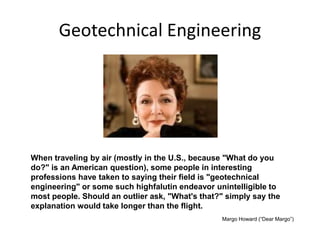Fascination About Geotheta
Fascination About Geotheta
Blog Article
Geotheta for Beginners
Table of Contents6 Easy Facts About Geotheta ShownThe Best Strategy To Use For Geotheta3 Simple Techniques For GeothetaSome Of Geotheta
They team up with civil designers, architectural engineers, designers, and other professionals to integrate geotechnical considerations into the total task style and construction procedure. This requires effective synergy, sychronisation, and communication to ensure that the geotechnical aspects line up with the project purposes and fulfill regulatory needs.Mining & Products Engineering: Concepts of exploration, penetration rates, and aspects affecting the choice of drilling method. Qualities of dynamites, shooting systems and blast patterns. Blowing up methods in surface and below ground operations. Unique blowing up methods at excavation perimeters. Vibration and sound control. Mechanical and constant techniques to fragmentation, including longwall shearing and fullface boring.
Integrated analysis of fragmentation and comminution operations. Supplied by: Mining & Products Design.
The Single Strategy To Use For Geotheta
Bachelor's degree programs in civil, geotechnical, geological, and environmental engineering generally last four years and consist of basic education programs in English, social scientific research, and the liberal arts, in addition to programs in advanced maths, structural geology, and fluid mineralogy. (https://fliphtml5.com/homepage/bdjcx/geotheta/)
Geotechnical design involves the evaluation of the soil and rock conditions at a specific site, and their effects for the advancement of that site. As most frameworks count on the ground for assistance, it lacks shock that a detailed understanding of the ground conditions, and the viability of structure systems, are vital to the long-term stability and efficiency of the building or framework.
Being experts in the examination of geological developments and ground practices, geotechnical designers perform scientific investigations and screening to understand the impact these geological developments might carry the style and building of building, civil and facilities projects. This know-how is important for the design and building and construction of structures, roads, tunnels, dams, bridges, and water and sewer systems.
The geotechnical group at Douglas Allies routinely talk to architects, design designers, designers, and contractors to make recommendations on design and development proposals to guarantee that the built structures are accordingly developed for the ground conditions. For instance, the style of footing systems needs to think about the weight of the framework, the ability of the ground to sustain that weight along with activity tolerances and reliable building and construction.
The Ultimate Guide To Geotheta
This job is significantly simplified by the usage of our Douglas Map geospatial system that makes this details conveniently obtainable in an easy to make use of web browser user interface. A geotechnical designer will certainly route the drilling of boreholes and examination pits to gather dirt and other samples, and additionally assess surface area attributes and ground exposures to create a geotechnical design of the subsurface problems.
Relying on the project kind and ground problems experienced, lab testing might to name a few things examine strength, compressibility, sensitivity and/or permeability of dirt and rock examples. After this information is accumulated and collated, the outcomes are used for a geotechnical design of the site, which is commonly presented as sections throughout the site.

A geotechnical investigation naturally can only examine the ground conditions at the locations drilled or dug deep into. Natural variations in soil and rock problems can take place across a site and in between examination places. It is for that reason excellent practice that the geotechnical designer be kept throughout building of the job to offer on-site confirmation that the ground problems experienced follow the expectations and suggestions supplied in the geotechnical examination report.
The Best Guide To Geotheta
Geotechnical designers use their extensive expertise of dirt and rock to assess danger and solve problems on diverse facilities projectsGeotechnical engineering is a specialist branch of civil engineering which checks out the behavior of earth products and the application of dirt and rock auto mechanics. Engineer of Record. As a geotechnical designer, you will assess the physical, mechanical and chemical homes of soil and rock in order to make structures, retaining frameworks and earthworks
Geotechnical engineering is carefully linked to and overlaps with, both design geology and ground engineering - http://prsync.com/geotheta/. It's feasible to specialise in geotechnics or help a geotechnical company however be referred to as an engineering geologist or a ground designer. As a geotechnical engineer, you'll need to: develop and keep connections with clients and various other specialists involved in the site, throughout each projectmaintain safety criteria on website be mindful of expense ramifications when you make recommendationsstudy geological maps and aerial photographs from a series of resources and from different time periodsexamine building intends to see how practical they are based upon your understanding of the siteinvestigate risks or geological risks for the sitesearch for ecologically sensitive functions, such as landfill beginning to create factual and interpretive ground modelsplan field investigationsdrill and evaluate samples of bedrock, soil, groundwater and added materials supervise various other experts on sitesolve technical problems as they emerge, such as unanticipated frameworks at drill sitesmonitor problems during and after building and construction to make certain frameworks are secure in the short go to the website and long termadding information gathered on site to your preliminary researchcreating geotechnical calculations, illustrations, and 2 or three-dimensional computer system versions analyzing the datamaking suggestions about the recommended usage of the site

Report this page